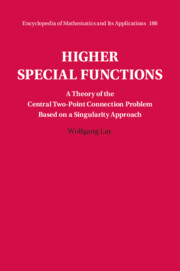 Higher Special Functions
Higher Special Functions Book contents
- Frontmatter
- Dedication
- Contents
- Preface
- Acknowledgements
- 1 Introduction
- 2 Singularities in Action
- 3 Fuchsian Differential Equations: The Cornerstones
- 4 Central Two-Point Connection Problems and Higher Special Functions
- 5 Applications and Examples
- 6 Afterword
- Appendix A Standard Central Two-Point Connection Problem
- Appendix B Curriculum Vitae of George Cecil Jaffé
- References
- Index
1 - Introduction
Published online by Cambridge University Press: 16 May 2024
- Frontmatter
- Dedication
- Contents
- Preface
- Acknowledgements
- 1 Introduction
- 2 Singularities in Action
- 3 Fuchsian Differential Equations: The Cornerstones
- 4 Central Two-Point Connection Problems and Higher Special Functions
- 5 Applications and Examples
- 6 Afterword
- Appendix A Standard Central Two-Point Connection Problem
- Appendix B Curriculum Vitae of George Cecil Jaffé
- References
- Index
Summary
Classical special functions are a traditional field of mathematics. As particular solutions of singular boundary eigenvalue problems of linear ordinary differential equations of second order, they are, by definition, functions that can be represented as the product of an asymptotic factor and a (finite or infinite) Taylor series. The coefficients of these series are, by definition, solutions of two-term recurrence relations, from which an algebraic boundary eigenvalue criterion can be formulated. This method is called the Sommerfeld polynomial method. Thus, one can say that the boundary eigenvalue condition is, by definition, algebraic in nature. It is the central message of this book that one can resolve this restriction methodically. The method developed for this also applies to problems that can be solved with classical methods. So, in order to present the newly developed method in light of what is known, and understand the new perspective more easily, the method is applied in this chapter to already known solutions. Accordingly, it is a ’phenomenological’ introduction, based on the ad hoc introduction of the relevant quantities.
Keywords
- Type
- Chapter
- Information
- Higher Special FunctionsA Theory of the Central Two-Point Connection Problem Based on a Singularity Approach, pp. 1 - 80Publisher: Cambridge University PressPrint publication year: 2024
